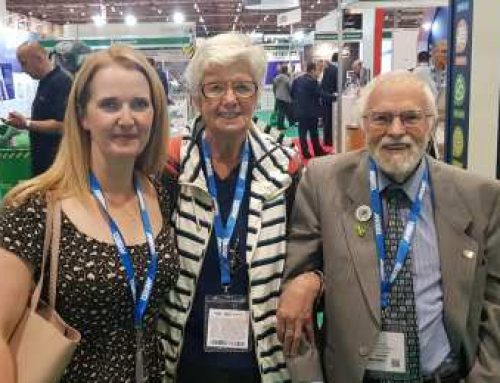We travelled to Newbury by train on Tuesday 23rd Jan and I just didn’t know what to expect. We have been to a training session before for Face Fit in Northampton but this was a Safety Seminar.
We arrived at Newbury Football Club and found and found an Exhibition laid out and a very warm welcome.
Darren greeted me, we have been in contact for a very long time as it has taken them a lot of planning to bring this to fruition.
The room filled up and we were soon seated to listen to the speakers.
I loved the way The three worked together with such enthusiasm, Darren O’Neill, Training & Consultancy Director, interacting with the group to raise more awareness about illnesses, diseases and anatomy, Gareth Davies (ESS Director) giving a brief overview of Asbestos Related information and Micky Harcourt, Business Development Manager at ESS giving an overview on Respirable Crystalline Silica each took it in turns to talk about the Company and the work they do with such pride. Not forgetting Catherine Storer Managing Director of ESS keeping everything running smoothly.

We travelled to Newbury by train on Tuesday 23rd Jan and I just didn’t know what to expect. We have been to a training session before for Face Fit in Northampton but this was a Safety Seminar.
We arrived at Newbury Football Club and found and found an Exhibition laid out and a very warm welcome.
Darren greeted me, we have been in contact for a very long time as it has taken them a lot of planning to bring this to fruition.
The room filled up and we were soon seated to listen to the speakers.
I loved the way The three worked together with such enthusiasm, Darren O’Neill, Training & Consultancy Director, interacting with the group to raise more awareness about illnesses, diseases and anatomy, Gareth Davies (ESS Director) giving a brief overview of Asbestos Related information and Micky Harcourt, Business Development Manager at ESS giving an overview on Respirable Crystalline Silica each took it in turns to talk about the Company and the work they do with such pride. Not forgetting Catherine Storer Managing Director of ESS keeping everything running smoothly.



Jane Beckman from the HSE Gave a good talk on covering an overview of their expectations and management HSE Have so much on Line Information we really ought to use it more.
Ray and I gave our presentation’s and Ray had made a new one and I hadn’t seen it. It was brilliant with some great cartoon pictures and my story. Ekk I couldn’t repeat it so I had to go along and swing it and also I had trouble working the clicker, but we got through and everyone was pleased with us so that’s the main thing.

My Charity Tin was left out and the audience put £75.50 in it which we counted when we got home and was surprised and thank them, xx
We covered so much it was great to have lunch and a chat with so many that were there. Since I have come home they all seem to contact and we have joined up on LinkedIn and Facebook. I seem to be in All Safety now.
After Lunch we did round robins where we split into groups and passed around the stalls.
Outside with a coat on we had a demonstration from Vern Harrington of RVT Group.
A demo https://rvtgroup.co.uk/equipment/dust/index.php


I have never seen the Taste face Fit test that was interesting to watch .
There are two tests :- Face Fit Testing (Qualitative)
This is a method used for checking that a tight-fitting face piece matches the person’s facial features and seals adequately to the wearers face. It also helps to ensure that poorly fitting face pieces are not selected for use. An inadequate fit will significantly reduce the protection provided to the wearer.
If a fit test is not performed, then an unsatisfactory seal / barrier may unknowingly exist. This could allow excessive leakage of airborne contaminants into the wearer’s breathing zone, even though the user is wearing a respirator correctly selected for the application.
We are happy to attend your site to carry out the Fit tests – each test takes approx. 15 – 20 mins per delegate.
Half day course – up to 12 delegates (based on one type of mask)
Cost: £350+Vat
Full day course – up to 22 delegates (based on one type of mask)
Cost: £485+Vat
Please can you confirm the type of mask currently being used along with the type of substances the delegates are working with?
Please ensure you are in possession of the masks you intend to use, or if you need further assistance with supplying these our tester can advise on the day:
If you do not have your own supply of masks we can bring various types of the FFP3 mask for testing on the day (reusable and non-reusable) and our tester will be able to advise on a suitable model for you to purchase going forward. This will be an additional cost of £25 (for a half day of testing), or £50 for a full day testing to cover the cost of the masks being used for testing purposes only. If you are using any dangerous chemicals please provide us with a COSHH sheet.
Face Fit Train the Tester (Qualitative)
This course is for trainees who want to undertake their own face fit testing programme.
Why perform a fit test?
If you provide respiratory protective equipment (RPE) to your employee’s then it is essential that you have documentary evidence to show the RPE fits the wearer. By subjecting each wearer to a face-fit test you can be sure that your organisation is fulfilling the requirements laid out in the Health & Safety Executives (HSE) guidance note HSE 282/28. I have attached a course overview for your information.
Course duration is approx. 4 hours and the course can accommodate a maximum of 6 delegates – cost is £425 + VAT.
Dates:
Fit Testing Kit
The cost of the Fit Testing Kit is an additional £150+Vat, and the tester can bring this with him on the day.
On completion of the above courses you will be provided with an Essential Site Skills ID Card and Certificate. We will also provide a USB drive with various documents for your learner to take away including HSE guidance, posters and employee fit test records for you to re-brand and use.
The Employee Fit Test Records and ID cards are valid for 3 years, but we would recommend a re-test after 12 months, due to any facial changes that may occur, beard growth, or if they have had a facial injury.
We offer an extensive range of training courses designed to meet the needs of industry and help ensure companies are fully compliant with legislation. I have attached a copy of our Company Brochure which includes an overview of the training, NVQ qualifications and services we offer; the course lists are not exhaustive but it gives an indication of the scope of our offer. Our open course dates can also be found on our website.
Dates for Courses found on the web site http://essentialsiteskills.co.uk/

Our Lungs are precious to us and they can be damaged so easily over the years that by the time we are older we can suffer with Lung disease. It’s not only Mesothelioma it is dust and fumes etc etc
The lungs are protected by a series of defense mechanisms in different regions of the respiratory tract.
When a person breathes in, particles suspended in the air enter the nose, but not all of them reach the lungs. The nose is an efficient filter. Most large particles are stopped in it, until they are removed mechanically by blowing the nose or sneezing.
Some of the smaller particles succeed in passing through the nose to reach the windpipe and the dividing air tubes that lead to the lungs [more information about how particles entering the lungs].
These tubes are called bronchi and bronchioles. All of these airways are lined by cells. The mucus they produce catches most of the dust particles. Tiny hairs called cilia, covering the walls of the air tubes, move the mucus upward and out into the throat, where it is either coughed up and spat out, or swallowed.
The air reaches the tiny air sacs (alveoli) in the inner part of the lungs with any dust particles that avoided the defenses in the nose and airways. The air sacs are very important because through them, the body receives oxygen and releases carbon dioxide.
Dust that reaches the sacs and the lower part of the airways where there are no cilia is attacked by special cells called macrophages. These are extremely important for the defense of the lungs. They keep the air sacs clean. Macrophages virtually swallow the particles. Then the macrophages, in a way which is not well understood, reach the part of the airways that is covered by cilia. The wavelike motions of the cilia move the macrophages which contain dust to the throat, where they are spat out or swallowed.
Besides macrophages, the lungs have another system for the removal of dust. The lungs can react to the presence of germ-bearing particles by producing certain proteins. These proteins attach to particles to neutralize them.
Dusts are tiny solid particles scattered or suspended in the air. The particles are “inorganic” or “organic,” depending on the source of the dust. Inorganic dusts can come from grinding metals or minerals such as rock or soil. Examples of inorganic dusts are silica, asbestos, and coal.
Organic dusts originate from plants or animals. An example of organic dust is dust that arises from handling grain. These dusts can contain a great number of substances. Aside from the vegetable or animal component, organic dusts may also contain fungi or microbes and the toxic substances given off by microbes. For example, histoplasmosis, psittacosis and Q Fever are diseases that people can get if they breathe in organic that are infected with a certain microorganisms.
Dusts can also come from organic chemicals (e.g., dyes, pesticides). However, in this OSH Answers document, we are only considering dust particles that cause fibrosis or allergic reactions in the lungs. We are not including chemical dusts that cause other acute toxic effects, nor long term effects such as cancer for example.
What are the reactions of the lungs to dust?
The way the respiratory system responds to inhaled particles depends, to a great extent, on where the particle settles. For example, irritant dust that settles in the nose may lead to rhinitis, an inflammation of the mucous membrane. If the particle attacks the larger air passages, inflammation of the trachea (tracheitis) or the bronchi (bronchitis) may be seen.
The most significant reactions of the lung occur in the deepest parts of this organ.
Particles that evade elimination in the nose or throat tend to settle in the sacs or close to the end of the airways. But if the amount of dust is large, the macrophage system may fail. Dust particles and dust-containing macrophages collect in the lung tissues, causing injury to the lungs.
The amount of dust and the kinds of particles involved influence how serious the lung injury will be. For example, after the macrophages swallow silica particles, they die and give off toxic substances. These substances cause fibrous or scar tissue to form. This tissue is the body’s normal way of repairing itself. However, in the case of crystalline silica so much fibrous tissue and scarring form that lung function can be impaired. The general name for this condition for fibrous tissue formation and scarring is fibrosis. The particles which cause fibrosis or scarring are called fibrogenic. When fibrosis is caused by crystalline silica, the condition is called silicosis.
What are the factors influencing the effects of dust?
Several factors influence the effects of inhaled particles. Among these are some properties of the particles themselves. Particle size is usually the critical factor that determines where in the respiratory tract that particle may be deposited. Chemical composition is important because some substances, when in particle form, can destroy the cilia that the lungs use for the removal of particles. Smoking may alter the ability of the lungs to clear themselves.
Characteristics of the person inhaling particles can also influence the effects of dust. Breathing rates and smoking are among the most important. The settling of dust in the lungs increases with the length of time the breath is held and how deeply the breath is taken. Whether breathing is through the nose or mouth is also important.
What are the diseases of dusty operations?
Workers can be affected from a variety of illnesses caused by dust they inhale in their work environments. For practical purposes, we limit this document to dust. We do not take into consideration combined effects arising from exposures to dusts, gases, fumes and vapours.
Some types of lung diseases caused by the inhalation of dust are called by the general term “pneumoconiosis”. This simply means “dusty lung”.
The changes which occur in the lungs vary with the different types of dust. For example, the injury caused by exposure to silica is marked by islands of scar tissue surrounded by normal lung tissue. Because the injured areas are separated from each other by normal tissue, the lungs do not completely lose their elasticity. In contrast, the scar tissue produced following exposure to asbestos, beryllium and cobalt completely covers the surfaces of the deep airways. The lungs become stiff and lose their elasticity.
Not all inhaled particles produce scar tissue. Dusts such as carbon and iron remain within macrophages until they die normally. The released particles are then taken in again by other macrophages. If the amount of dust overwhelms the macrophages, dust particles coat the inner walls of the airways without causing scarring, but only producing mild damage, or maybe none at all.
Some particles dissolve in the bloodstream. The blood then carries the substance around the body where it may affect the brain, kidneys and other organs.
The table below summarizes some of the most common lung diseases caused by dust.
The OSH Answers document Extrinsic Allergic Alveolitis has more information about diseases from exposure to organic dusts.
Table
Some types of pneumoconiosis according to dust and lung reaction
Inorganic Dust
Type of Disease
Lung Reaction
Asbestos
Asbestosis
Fibrosis
Silica (Quartz)
Silicosis
Fibrosis
Coal
Coal Pneumoconiosis
Fibrosis
Beryllium
Beryllium Disease
Fibrosis
Tungsten Carbide
Hard Metal Disease
Fibrosis
Iron
Siderosis
No Fibrosis
Tin
Stannosis
No Fibrosis
Barium
Baritosis
No Fibrosis
Organic Dust
Mouldy hay, straw and grain
Farmer’s lung
Fibrosis
Droppings and feathers
Bird fancier’s lung
Fibrosis
Mouldy sugar can
Bagassosis
Fibrosis
Compose dust
Mushroom worker’s lung
No Fibrosis
Dust or mist
Humidifier fever
No Fibrosis
Dust of heat-treated sludge
Sewage sludge disease
No Fibrosis
Mould dust
Cheese washers’ lung
No Fibrosis
Dust of dander, hair particles and dried urine of rats
Animal handlers’ lung
No Fibrosis
How can we protect the lungs from dust?
To avoid respiratory or other problems caused by exposure to dust, controls must be implemented. As per the hierarchy of control, the first consideration should be hazardous substances substituted with non-hazardous substances. Where substitution is not possible, other engineering control methods should be introduced. Some examples are:
use of wet processes
enclosure of dust-producing processes under negative air pressure (slight vacuum compared to the air pressure outside the enclosure)
exhausting air containing dust through a collection system before emission to the atmosphere
use of vacuums instead of brooms
good housekeeping
efficient storage and transport
controlled disposal of dangerous waste
Use of personal protective equipment may be vital, but it should nevertheless be the last resort of protection. Personal protective equipment should not be a substitute for proper dust control and should be used only where dust control methods are not yet effective or are inadequate. Workers themselves, through education, must understand the need to avoid the risks of dust. A respiratory protection program is discussed in OSH Answers – Personal Protective Equipment, and specifically Respirator Selection, Respirator Care, Respirators – Wearing a Respirator and Respirators – Respirator Versus Surgical Masks.
http://www.ccohs.ca/oshanswers/chemicals/lungs_dust.html
We were shattered as we travelled home in the rush hour and don’t I look it.

I know it doesn’t look it but I had a great day and so pleased we did attend this great Seminar Thank You ESS.







Leave A Comment